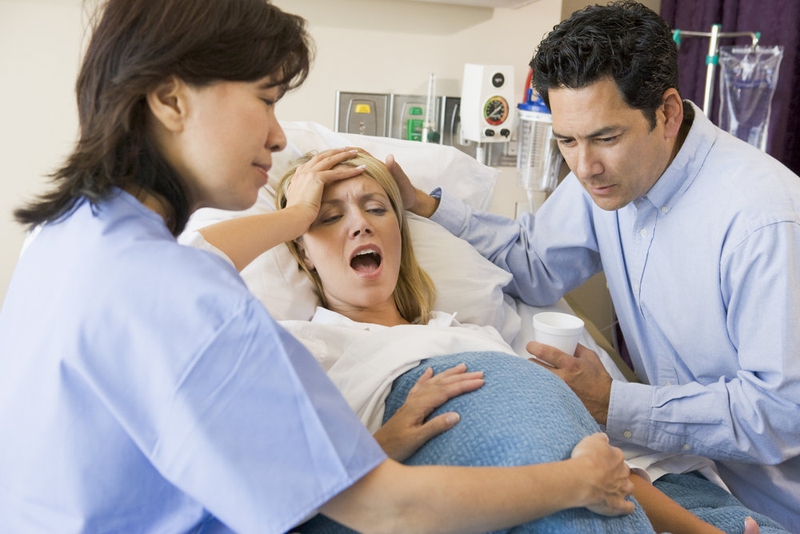You are likely to experience contractions or labor pains towards the end of your pregnancy. As the body starts getting ready to deliver the baby, the uterine muscles experience periodic tightening and relaxing which can be considerably painful. If you are wondering where you should feel your contractions, they usually start at the back and move to the front of the body. Most women describe labor pains as similar to cramping pains during their period. The degree of pain depends on the position of the baby as well as the stage of labor. To answer the question as to "Where do you feel contractions", some women feel them in the lower abdomen while others have reportedly felt pressure on the pelvic region.

Where Do You Feel Contractions?
The gestational period of a pregnancy is between 37-42 weeks. This is the window where you feel contractions.
Doctors calculate the due date based on the first day of your last menstrual cycle. They usually recommend an ultrasound to confirm how far along you are. As a pregnant woman reaches her due date, the body starts getting ready to stretch. The upper part of the uterus tightens whereas the lower part begins to relax, so the baby can easily pass through it. Real contractions last between 30-70 seconds, and get stronger and more frequent as time passes.
Before the Real Contraction Starts
As the uterus gets ready, the muscles tighten and relax. This can be significantly painful as the pain peaks and then fades in a wave. The answer to "Where do you feel contractions" is dependent on the position of the baby and stage of labor, but it is usually a backache that travels to the pelvic area and puts pressure on it. As the time draws near, the contractions get closer in occurrence and are usually back to back. Their intensity also increases so that the mom-to-be can barely catch her breath.
When the Contractions Start, the Real Contractions
Real contractions cause the cervix to dilate or open up. Here are the contractions in the three stages of labor:
The opening of the cervix is the first stage of labor. Some women go into labor without having any pain but for most, labor pains intensify as the cervix opens. This is one of the most painful parts of labor.
Once your cervix is fully dilated, you enter stage two of labor which is when the baby starts pushing itself down as it prepares to make an entrance into the world. It is important to be with your health care professional in this stage because making its way out is a laborious task for the baby and it can stress it out. Your doctor is probably monitoring the baby's breath and heart rate as you push to ease its exit from the womb. Make sure to have a trusted person nearby as this is a very crucial part of labor.
Stage three of labor is when the placenta is detached from the uterus so it can be pushed out. The pain associated with contractions usually fades by this time.
True Contraction VS. False Contraction
True contractions are a sure shot sign that the body is ready to deliver the baby. However, there are two types of contractions, the true contractions that are a sign of incoming labor and Braxton Hicks or practice contractions that happen as the body prepares and stretches for delivery.
Braxton Hicks are usually less painful than real contractions and should not be mistaken as a sign of labor. The stomach will feel tight to the touch in both cases as the uterine muscles stretch but it is the timing and degree of pain that will help you distinguish between the two. For first time moms, it is very important to differentiate between the two. Even women who have been through the process earlier may get confused but before you rush to the hospital, it would be beneficial if you confirm that it is indeed labor.
There are some crucial differences between the two:
Real contractions are regularly spaced. There is a pattern to them and if you time where contractions are felt, you will notice that they last 30-70 seconds and become more frequent as time passes. False contractions are sporadic and irregular and can come and go.
Try moving or changing your position. If it is false labor, the contractions you feel are likely to stop if you move around whereas real contractions will continue to happen.
Real contractions become more intense as time passes but if your contractions are weak and then become strong or vice versa than it is likely a false alarm.
Ask yourself where you feel the contractions. If the pain is limited to the front of the abdomen or pelvic area, then it is false labor; whereas real labor starts from the lower back and travels to the front of the abdomen in a wave like manner.
If you are in pain, drink water and rest. If the contractions lose their strength or stop, then the body is simply practicing for labor; but if the painful waves continue, then it is real labor. You can try keeping your feet up and if it's false labor, the pain will likely subside.
If your water breaks, you have blood in your discharge or your mucus plus comes off, then it is a sign of labor and a trip to the hospital, along with your baby bag is recommended.
Braxton Hicks can occur as early as the second trimester, but pregnant women are more likely to experience them in the third trimester and usually nearing the due date which can cause some confusion.

View All Comments /Add Comment